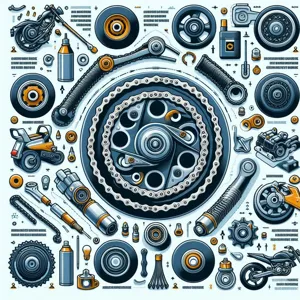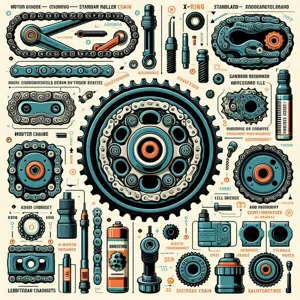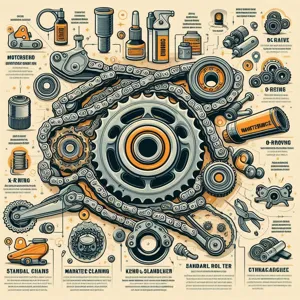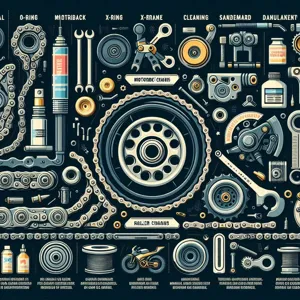For motorcycle enthusiasts, understanding the intricacies of their ride is as crucial as the thrill of the open road itself.
One of the most vital yet often overlooked components of a motorcycle is its chain—a critical element that powers your machine and ensures a smooth ride. With various chain types available, each designed for specific riding styles and performance needs, navigating this aspect of motorbike maintenance can be overwhelming. In this comprehensive guide, we will unlock the secrets of motorbike chain types, exploring everything from O-ring and X-ring chains to the best options for off-road adventures. But we won’t stop there; we’ll also delve into essential maintenance tips that will keep your chain in optimal condition, extend its lifespan, and enhance your overall riding experience. Whether you’re a seasoned rider or a newcomer to the world of motorbikes, this post will equip you with the knowledge you need to keep your bike running smoothly and efficiently. So, gear up and get ready to learn how to keep your ride at its best!
1. Introduction to Motorbike Chains: Importance and Function

When it comes to the intricate machinery of a motorbike, the chain might not be the first component that springs to mind, yet its significance cannot be overstated. The motorbike chain serves as the vital link between the engine and the wheels, transmitting power with remarkable efficiency. This essential component is responsible for converting the rotational energy generated by the engine into the forward momentum that propels your bike down the road. Without a properly functioning chain, even the most advanced motorbike would struggle to perform effectively, leaving riders stranded and frustrated.
Motorbike chains come in various types, each designed to cater to different styles of riding and performance requirements. Understanding these variations is crucial for any biker, as the right chain can enhance not only the bike’s performance but also its longevity. From standard roller chains to O-ring and X-ring options that reduce friction and wear, the choice of chain can dramatically impact your riding experience. Additionally, a well-maintained chain ensures smoother rides, more efficient power transfer, and reduced risk of unexpected breakdowns.
In this guide, we’ll delve into the different types of motorbike chains available on the market, exploring their unique features, benefits, and ideal applications. We’ll also cover essential maintenance tips that will keep your chain in optimal condition, helping you unlock the full potential of your ride. Whether you’re a seasoned rider or a newcomer to the biking world, understanding the importance and function of motorbike chains is the first step toward a safer, more enjoyable journey on two wheels.
2. Types of Motorbike Chains: An Overview
When it comes to motorbike chains, understanding the various types available can significantly enhance your riding experience and longevity of your bike. The right chain not only affects performance but also contributes to safety and efficiency. Here’s a closer look at the main types of motorbike chains, each tailored to meet specific riding needs and styles.
**1. Roller Chains:** The most common type found on motorcycles, roller chains are composed of inner and outer links, with rollers that allow for smooth movement over the sprockets. They are suitable for a wide range of bikes, from cruisers to sport bikes, providing a balance of durability and flexibility. These chains are typically made from steel, offering excellent strength while maintaining a reasonable weight.
**2. O-ring Chains:** Designed to handle higher performance demands, O-ring chains feature rubber O-rings that sit between the inner and outer links. These rings help retain lubrication within the chain, reducing friction and wear, which is particularly beneficial for high-speed or off-road riding. O-ring chains are more resistant to dirt and grime, making them a popular choice for adventure and touring motorcycles.
**3. X-ring Chains:** An evolution of the O-ring chain, X-ring chains utilize a four-point contact design that further minimizes friction and enhances durability. The X-shaped O-rings provide a more effective seal, keeping lubricant in and contaminants out. Though they may come at a higher price point, the added longevity and reduced maintenance make them a preferred option for serious riders and racers.
**4. Heavy-Duty Chains:** Specifically engineered for extreme conditions, heavy-duty chains offer reinforced links and are often used in off-road motorcycles or machines requiring extra strength. These chains can withstand the rigors of rough terrain and heavy loads, ensuring reliability when you need it the most.
**5. Custom Chains:** For those who want to express individuality or tailor performance to specific riding styles, custom chains are available. These can include varying colors, finishes, and even materials like titanium for a unique touch that doesn’t compromise strength.
Understanding these chain types is crucial for selecting the right one for your motorbike. Each has its own advantages and is suited for different riding conditions, so consider your riding style and frequency when making a choice. Regardless of the type you choose, regular maintenance will ensure your chain performs optimally and keeps you safely on the road.
– 2.1. Roller Chains

Roller chains are the backbone of most motorbike drive systems, providing a reliable and efficient means of transferring power from the engine to the rear wheel. Characterized by their unique design, roller chains consist of a series of interlinked metal links, each equipped with a small cylindrical roller that facilitates smooth movement over the sprockets. This roller design minimizes friction, enhancing the overall performance of the bike while ensuring a longer lifespan for the chain and sprockets.
One of the standout features of roller chains is their versatility. They come in various sizes and configurations, making them suitable for a wide range of motorbike types, from cruisers to sport bikes. The most common sizes used in motorbikes are ANSI (American National Standards Institute) sizes, which are categorized by pitch and width. When selecting a roller chain for your bike, it’s crucial to match the correct size to your specific model to ensure optimal performance and safety.
Maintenance is key to keeping roller chains in top condition. Regularly lubricating the chain is essential, as it helps reduce wear and tear while preventing rust and corrosion. A well-lubricated chain operates quietly and efficiently, enhancing your riding experience. Additionally, it’s important to check the chain tension regularly; a chain that is too loose can skip off the sprockets, while one that is too tight can strain the engine and lead to premature wear.
Inspecting the chain for any signs of damage, such as stiff links or excessive elongation, is also vital. If left unaddressed, these issues can compromise not only the chain’s performance but also the safety of your ride. Replacing a worn or damaged roller chain promptly can save you from more extensive repairs down the line and keep your bike running smoothly.
In summary, roller chains are a fundamental component of motorbike mechanics, offering efficiency and reliability when properly maintained. By understanding their function and committing to regular upkeep, you can unlock the full potential of your ride, ensuring many miles of enjoyable motorcycling ahead.
– 2.2. O-ring Chains
O-ring chains have become a staple in the world of motorbiking, and for good reason. Characterized by their unique design, these chains feature rubber O-rings nestled between the outer and inner plates. This innovative addition is not merely cosmetic; it serves a crucial purpose by sealing the lubricant within the chain, significantly reducing friction and wear. As a result, O-ring chains offer unparalleled longevity and performance, making them an excellent choice for both casual riders and seasoned motorcyclists.
One of the standout benefits of O-ring chains is their ability to withstand the rigors of varied riding conditions. Whether you’re navigating through heavy rain, facing muddy terrains, or cruising along smooth highways, these chains maintain their integrity and efficiency. The sealed lubrication prevents contaminants like dirt, water, and debris from penetrating the inner workings, ensuring smoother operation and reducing the need for frequent adjustments.
Furthermore, O-ring chains are renowned for their strength and durability. They are typically constructed from high-quality materials that can endure significant stress, making them ideal for high-performance bikes that demand resilience. This durability translates to fewer replacements over time, saving you both money and hassle in the long run.
Maintenance of an O-ring chain is relatively straightforward. Regular cleaning with a suitable chain cleaner and lubricant designed specifically for O-ring chains will help maintain their optimal performance. Unlike non-O-ring chains, which may require more frequent adjustments, O-ring chains often retain their tension longer, allowing you to enjoy extended rides without constant worry about wear and tear.
In summary, if you’re looking for a reliable and efficient option for your motorbike, O-ring chains are undoubtedly a top contender. Their unique design not only enhances performance but also offers riders peace of mind, knowing that their chain can withstand the demands of the road ahead. Whether you’re commuting daily or embarking on weekend adventures, investing in an O-ring chain is a decision that will surely pay off in the long run.
– 2.3. X-ring Chains

X-ring chains are often considered the pinnacle of motorbike chain technology, offering an exceptional blend of durability, efficiency, and performance. Unlike traditional O-ring chains, which utilize round rubber O-rings to seal in lubrication, X-ring chains feature a unique cross-shaped design that enhances their sealing capabilities. This innovative design minimizes friction and maximizes the chain’s lifespan, making it a favored choice among both casual riders and professional racers alike.
The X-ring’s distinctive shape allows for better lubrication retention, reducing the wear on both the chain and the sprockets. This means that not only will you experience smoother gear shifts and improved acceleration, but you’ll also spend less time and money on replacements and maintenance. In fact, many riders report that X-ring chains can last up to twice as long as their O-ring counterparts, even under harsh riding conditions.
Another significant advantage of X-ring chains is their reduced weight. With less friction comes less resistance, which not only enhances performance but also improves fuel efficiency. For the performance enthusiast looking to shave off every ounce of weight, this chain type is a smart investment.
However, it’s essential to remember that while X-ring chains offer superior performance, they also require proper maintenance to reach their full potential. Regular cleaning and lubrication are critical to prevent dirt and grime buildup, which can compromise the integrity of the seals. Using a quality chain cleaner and lubricant specifically designed for X-ring chains will help ensure longevity and optimal performance.
In conclusion, X-ring chains represent a technological advancement in motorbike chains, offering riders a perfect blend of longevity, minimal maintenance, and superior performance. Investing in an X-ring chain could mean the difference between a smooth ride and frequent repairs, making it a worthy consideration for your motorbike.
– 2.4. Non-sealed Chains
Non-sealed chains, often referred to as open chains, represent a more traditional design in the world of motorbike chains. Unlike their sealed counterparts, which come with O-rings or X-rings to keep lubrication in and dirt out, non-sealed chains rely solely on the careful application of lubricant to ensure smooth operation. This lack of protective seals allows for a lighter weight and a simpler construction, making non-sealed chains a popular choice for certain types of motorcycles, particularly older models and some off-road bikes.
While non-sealed chains can provide a more direct connection between the engine and the wheels, they require a diligent maintenance routine to function optimally. Because they are more susceptible to dirt and grime, it is crucial to clean and lubricate them regularly. A basic cleaning involves removing any debris and applying a quality chain lubricant, which helps reduce friction and wear. It’s advisable to check the chain tension frequently, as loose chains can lead to poor performance and increased wear on both the chain and sprockets.
One of the key advantages of non-sealed chains is their cost-effectiveness. They are generally less expensive than sealed chains, making them an appealing option for riders looking to save on maintenance costs. However, this cost savings comes with the caveat of increased maintenance needs, as riders must be committed to regular upkeep to ensure longevity.
Moreover, non-sealed chains can offer a bit more flexibility in terms of customization and performance. Riders who enjoy tweaking their machines might appreciate the straightforward installation and adjustment process that non-sealed chains provide. However, it’s essential to remember that without the added protection of seals, these chains may wear out faster than their sealed counterparts, especially in harsh riding conditions or environments laden with mud and debris.
In summary, non-sealed chains can be a rewarding choice for those willing to invest the time and effort into regular maintenance. With the right care, they can offer a reliable performance for riders who appreciate a more classic approach to motorbike mechanics. Whether you’re hitting the open road or tackling rugged trails, understanding the characteristics and maintenance needs of non-sealed chains will help you unlock the full potential of your ride.
3. Choosing the Right Chain for Your Motorbike

Choosing the right chain for your motorbike is crucial for ensuring optimal performance, safety, and longevity of your ride. Motorcycle chains come in different types, and understanding these varieties is essential for making an informed decision that fits your riding style and bike specifications.
First, consider the material of the chain. Most motorbike chains are made from high-quality steel, but you can also find chains that incorporate advanced materials such as aluminum or carbon, which offer lighter weight and improved performance. For everyday riders, a conventional steel chain will suffice, while performance enthusiasts may want to explore options that provide weight savings and reduced friction.
Next, take into account the chain’s construction. Chains are generally classified into roller chains, which are the most common type, and O-ring or X-ring chains, which feature rubber seals that help retain lubrication and protect against dirt and grime. O-ring and X-ring chains are particularly favored for their durability and reduced maintenance needs, making them ideal for riders who frequently tackle longer trips or off-road adventures.
Another critical factor to consider is the chain’s pitch and width. The pitch refers to the distance between the pins of the chain links, while the width determines how well the chain fits onto your sprockets. Always consult your motorbike’s owner’s manual for the specific requirements, as using an incorrect chain size could lead to poor performance or premature wear.
Lastly, don’t overlook the importance of quality and brand reputation. Opt for chains from reputable manufacturers known for their reliability and performance. A well-regarded chain can mean the difference between a smooth ride and unexpected failures on the road.
By taking the time to choose the right chain for your motorbike, you’ll not only enhance your riding experience but also extend the life of your bike’s drivetrain. A little research can go a long way, so gear up and ensure you make an informed choice before hitting the open road.
4. Key Factors to Consider When Selecting a Chain
When it comes to selecting the right chain for your motorbike, several key factors come into play. The chain is not just a component; it’s the vital link between the engine and the rear wheel, translating power into motion. Therefore, making an informed choice is paramount.
**1. Chain Type:** The first consideration is the type of chain that best suits your riding style and motorcycle. There are primarily three types: roller chains, o-ring chains, and x-ring chains. Roller chains are the most basic and economical, ideal for casual riders. O-ring and x-ring chains, on the other hand, offer enhanced durability and reduced friction, making them perfect for performance and off-road bikes. They are designed to retain lubrication and keep dirt out, extending their lifespan significantly.
**2. Size and Pitch:** The size of the chain and its pitch—measured in inches between the pins—are crucial for compatibility with your bike. Using the correct size ensures optimal performance and safety. Always refer to your motorcycle’s manual to find the specific size required.
**3. Strength Rating:** The strength of the chain is another vital factor, especially for high-powered bikes. Chains are rated by their tensile strength, which indicates how much force they can withstand before breaking. Choosing a chain with a strength rating that exceeds your bike’s horsepower is essential for safe riding and longevity.
**4. Maintenance Needs:** Different chains have varying maintenance requirements. O-ring and x-ring chains might need less frequent lubrication compared to traditional roller chains due to their design. If you’re a rider who prefers low-maintenance solutions, investing in an o-ring or x-ring chain could save you time and effort in the long run.
**5. Cost vs. Quality:** It’s tempting to go for the cheapest option available, but remember that the chain is a critical safety component. While it’s important to stay within budget, investing a little more in a high-quality chain can provide better performance and durability, ultimately saving you money on replacements and repairs in the future.
By carefully evaluating these factors, you’ll not only choose the right chain for your motorbike but also enhance your riding experience with improved safety and performance. The right chain is an investment in your bike’s longevity and your riding enjoyment, unlocking the full potential of your two-wheeled adventures.
5. Essential Tools for Chain Maintenance
When it comes to maintaining your motorbike chain, having the right tools on hand is crucial to ensuring a smooth and efficient process. Investing in quality tools not only simplifies the maintenance routine but also enhances the longevity of your chain, ultimately leading to a safer and more enjoyable ride. Here’s a rundown of essential tools that every motorbike owner should consider having in their maintenance arsenal.
**1. Chain Cleaning Brush:** A specialized chain cleaning brush, often featuring stiff bristles, is designed to reach into the intricate linkages of your chain. This tool allows you to remove grime and debris that can accumulate over time, ensuring your chain runs smoothly and efficiently. Regular cleaning can prevent wear and tear and keep your chain looking as good as new.
**2. Chain Cleaner:** Pair your brush with a high-quality chain cleaner. These cleaners are formulated to dissolve dirt, grease, and old lubricant without damaging the chain. Look for biodegradable options that are safe for the environment and your bike. A clean chain not only performs better but also enhances the overall efficiency of your motorbike.
**3. Chain Lubricant:** After cleaning, it’s essential to apply a suitable lubricant. Choose a product specifically designed for motorbike chains, as it will provide the right viscosity and stickiness to protect against wear while repelling dirt and moisture. Regular lubrication is key to preventing rust and ensuring a long-lasting chain.
**4. Chain Tool Kit:** A chain tool kit is invaluable for those who want to perform deeper maintenance tasks. This typically includes a chain breaker for removing and installing links, a riveting tool for securing new links, and a chain alignment tool to ensure proper tension and alignment. These tools allow you to replace or repair your chain with confidence.
**5. Torque Wrench:** Proper tension is essential for chain performance and longevity. A torque wrench ensures that you can tighten bolts and adjust tension to the manufacturer’s specifications, preventing over-tightening that can lead to premature wear or damage.
**6. Rags and Gloves:** Keeping your hands and workspace clean is essential during maintenance. Use rags to wipe down your chain and remove excess lubricant, and wear gloves to protect your hands from grease and chemicals.
By equipping yourself with these essential tools, you’ll be well-prepared to keep your motorbike chain in top condition. Regular maintenance not only enhances your bike’s performance but also contributes to a safer riding experience, allowing you to focus on the thrill of the ride.
6. How to Properly Clean Your Motorbike Chain
Cleaning your motorbike chain is a crucial part of maintenance that can significantly extend its lifespan and enhance your riding experience. A clean chain ensures smoother operation, reduces wear on the sprockets, and improves overall performance. Here’s how to do it properly.
**Gather Your Tools**
Before you dive into the cleaning process, make sure you have the right tools at hand. You’ll need a chain cleaner or degreaser, a soft brush (like a toothbrush), a microfiber cloth, and possibly a chain brush for tougher grime. Additionally, having a pair of protective gloves can keep your hands clean and safe from harsh chemicals.
**Get Your Bike Ready**
Position your motorbike on a stable surface and, if possible, use a paddock stand to elevate the rear wheel. This will allow you to spin the wheel freely and access the entire length of the chain without obstruction. If you don’t have a stand, you can simply place the bike on its side stand, but make sure it’s stable.
**Apply the Cleaner**
Spray the chain cleaner generously onto the chain. Allow it to sit for a few minutes to break down the dirt and grime. If you’re using a degreaser, be cautious, as some may be too harsh and could damage the O-rings in the chain. Always check the label for compatibility with your chain type.
**Scrub Away the Grime**
Using your soft brush, gently scrub the chain while rotating the wheel. Focus on the links and rollers, as these areas tend to accumulate the most debris. If you have a chain brush, this can make the process easier, as it is designed to reach into the nooks and crannies of the chain. Be thorough but gentle to avoid damaging any parts.
**Rinse and Dry**
Once you’ve scrubbed the chain, rinse off the cleaner with water, or wipe it down with a damp cloth. Ensure all residues are removed, as leftover cleaner can attract dirt and grime. After rinsing, thoroughly dry the chain with a microfiber cloth to prevent rusting.
**Lubricate the Chain**
After cleaning, it’s essential to lubricate the chain. Apply a quality chain lubricant evenly while slowly rotating the wheel. Ensure the lube penetrates the rollers and links, but avoid over-lubricating, as excess lubricant can attract dirt.
**Final Checks**
Once you’ve cleaned and lubricated the chain, give it a visual inspection. Look for any signs of wear or damage, such as stiff links or excessive wear on the sprockets. If you notice any issues, address them promptly to prevent further damage.
By incorporating regular chain cleaning into your maintenance routine, you’ll not only ensure a smoother ride but also extend the life of your motorbike’s chain and sprockets. A clean chain is a happy chain, and a happy chain leads to a happy rider!
7. Lubrication: Types of Lubricants and Application Tips
Proper lubrication is crucial for ensuring the longevity and optimal performance of your motorbike chain. A well-lubricated chain not only reduces friction and wear but also enhances the overall efficiency of your bike’s drivetrain. However, with various types of lubricants available on the market, it can be overwhelming to determine which one is best suited for your needs.
### Types of Lubricants
1. **Oil-Based Lubricants**: These are the most common types of chain lubricants, often derived from petroleum. They penetrate well and provide good lubrication, but they can attract dirt and grime, which may lead to more frequent cleaning of your chain.
2. **Wax-Based Lubricants**: Wax lubricants create a protective layer on the chain that repels dirt and moisture. They are particularly effective in keeping your chain clean; however, they may require more frequent application, especially in wet conditions.
3. **Dry Lubricants**: Often made from a mixture of wax and Teflon, dry lubricants are ideal for riding in dusty environments. They go on wet but dry quickly, leaving a clean, non-sticky finish that repels dirt and debris.
4. **Ceramic Lubricants**: These high-performance lubricants contain microscopic ceramic particles that create an ultra-smooth surface on the chain. They reduce friction exceptionally well and can enhance chain life, making them a popular choice among serious riders.
### Application Tips
– **Clean the Chain First**: Before applying any lubricant, ensure the chain is clean. Use a chain cleaner or degreaser to remove old lubricant and grime. A clean surface allows the new lubricant to penetrate effectively.
– **Apply Evenly**: Whether you prefer a spray or a liquid, apply the lubricant evenly along the length of the chain while rotating the rear wheel to ensure complete coverage. Aim to coat the inner links and rollers, where friction occurs most.
– **Let it Settle**: After application, give the lubricant some time to settle into the chain. Most riders recommend letting it sit for about 10-15 minutes before wiping off any excess. This ensures that the lubricant has penetrated fully without attracting unnecessary dirt.
– **Regular Maintenance**: Make lubrication a part of your regular maintenance routine. Depending on your riding conditions, check your chain every few rides, and lubricate as needed. Riding in wet or dusty environments may require more frequent applications.
By understanding the different types of lubricants and following these application tips, you can keep your motorbike chain in prime condition, ensuring a smoother ride and extending the life of your bike. Remember, a well-maintained chain is key to unlocking the full potential of your motorcycle!
8. Adjusting Chain Tension: Why It Matters
Adjusting chain tension is a crucial aspect of motorbike maintenance that often gets overlooked by riders eager to hit the open road. The chain is not merely a connector; it plays a vital role in translating the power generated by your engine into motion. An improperly tensioned chain can lead to a host of problems, including reduced performance, excessive wear, and potentially dangerous riding conditions.
When a chain is too loose, it can skip over the sprockets or even derail, leading to a sudden loss of power and control. This can not only ruin your ride but could also result in catastrophic accidents. Conversely, a chain that is too tight can place undue stress on the engine and transmission, leading to premature wear and tear. This imbalance can also cause the chain to stretch or even break, leaving you stranded and facing an expensive repair bill.
To ensure your chain is always in the optimal tension range, it’s essential to consult your motorbike’s owner manual, which typically provides specific guidelines for your make and model. Generally, you should inspect your chain tension regularly, especially before long rides or after significant mileage. Adjusting the tension involves loosening the axle nuts, making the necessary adjustments using the adjusters on the swingarm, and then tightening everything back up.
Regularly checking and adjusting chain tension not only extends the lifespan of your chain and sprockets but also enhances your overall riding experience. A well-maintained chain translates to smoother gear shifts, improved fuel efficiency, and a safer ride. So, take the time to give your chain the attention it deserves; it’s the key to unlocking the full potential of your motorbike.
9. Signs of Chain Wear and When to Replace
As a crucial component of your motorbike’s performance, the chain endures significant stress and strain during every ride. Knowing the signs of chain wear is essential to ensure your safety and maintain optimal efficiency. Regular inspections can save you from costly repairs and enhance your riding experience.
One of the first indicators of chain wear is noticeable stiffness. If the links seem resistant or difficult to move when you try to flex them, it’s a clear signal that your chain is nearing the end of its life. Additionally, look for signs of elongation; a stretched chain will have increased play between the links, which can lead to poor gear shifting and reduced power transfer from the engine to the wheels.
Another critical sign to watch for is excessive rust or corrosion. While a bit of surface rust can be typical, deep rust can weaken the links, making them more prone to breakage. If you notice pitting or flaking on the metal, it’s time to consider a replacement. Also, pay attention to the sprockets; if the teeth are worn down or exhibit a shark-fin shape, your chain may not mesh properly, increasing the risk of failure.
Finally, listen for unusual noises while riding. A well-maintained chain should operate quietly, so any clinking or grinding sounds could indicate serious wear. If your chain exhibits one or more of these signs, don’t hesitate to replace it. A fresh chain not only ensures a safer ride but can also improve your bike’s overall performance, making every journey smoother and more enjoyable. Regular maintenance checks and timely replacements will keep your motorbike running like new and enhance your confidence on the road.
10. Common Chain Maintenance Mistakes to Avoid
Maintaining your motorbike’s chain is crucial for ensuring a smooth ride, optimal performance, and extending the lifespan of your bike. However, even seasoned riders can fall into common traps when it comes to chain maintenance. Here are some critical mistakes to avoid to keep your chain in top condition.
**Neglecting Regular Inspections:** One of the biggest mistakes riders make is overlooking the importance of periodic chain inspections. Regularly checking for signs of wear, rust, or damage can help you catch issues before they escalate. A quick visual check can save you from a much bigger problem down the road.
**Skipping Cleaning:** Dirt, grime, and debris can accumulate on your chain, leading to accelerated wear and tear. Failing to clean your chain regularly not only affects its performance but can also impact the overall performance of your bike. Make it a habit to clean your chain after every ride, especially if you’ve been on muddy or dusty roads.
**Using the Wrong Lubricant:** Not all lubricants are created equal, and using the wrong type can lead to more harm than good. Avoid using general-purpose oils; instead, opt for a lubricant specifically designed for motorbike chains. This ensures optimal performance and protection against the elements.
**Over-Lubricating:** While lubrication is essential, overdoing it can lead to a messy situation. Excess lubricant can attract dirt, creating a sticky residue that can damage your chain and sprockets. Use just enough lubricant to coat the chain without excessive buildup.
**Ignoring Tension Adjustments:** A common oversight is failing to adjust the chain tension as needed. A chain that is too loose can slip off, while one that is too tight can cause premature wear on both the chain and sprockets. Familiarize yourself with the manufacturer’s specifications for tension and make adjustments as needed.
**Forgetting the Sprockets:** While the chain often gets the most attention, neglecting the sprockets can lead to uneven wear and potential failure. Regularly inspect your sprockets for signs of wear, such as hooked teeth, and replace them along with your chain as needed.
By avoiding these common chain maintenance mistakes, you can ensure a smoother, safer ride and prolong the life of your motorbike’s chain. Remember, a well-maintained chain isn’t just about performance; it’s also about your safety on the road.
11. The Impact of Chain Maintenance on Performance
Chain maintenance is often the unsung hero in the world of motorbike performance, yet its impact cannot be overstated. The chain is a crucial component of your bike’s power delivery system, transmitting the engine’s torque to the rear wheel. A well-maintained chain not only ensures smooth acceleration but also contributes to the overall efficiency of your bike, directly affecting fuel consumption and ride quality.
Neglecting your chain can lead to a host of issues that diminish performance. A dirty or dry chain increases friction, resulting in sluggish acceleration and power loss. Conversely, an over-lubricated chain can attract dirt and debris, leading to premature wear and tear. This wear manifests as stiff links or elongation, causing misalignment with the sprockets and potentially jeopardizing the entire drivetrain.
Regularly inspecting and cleaning your chain is essential. This simple act can prevent the accumulation of grime that hinders performance and prolongs the lifespan of both the chain and sprockets. Adequate lubrication is equally important; applying the right lubricant at the correct intervals helps maintain flexibility in the chain links, allowing for smooth operation and reducing the risk of snapping under pressure.
Additionally, keeping your chain properly tensioned is vital. A loose chain can skip teeth on the sprockets, while a chain that’s too tight can strain the engine and lead to damage. Finding the right tension ensures optimal power transfer and enhances your overall riding experience.
In summary, prioritizing chain maintenance not only boosts your motorbike’s performance but also enhances safety and reduces long-term repair costs. By investing a little time and effort into this often-overlooked aspect of motorbike care, you’ll unlock the full potential of your ride and enjoy a smoother, more exhilarating journey on every adventure.
12. Tips for Extending the Life of Your Motorbike Chain
Extending the life of your motorbike chain is not just about saving money; it’s about ensuring a smoother ride and enhancing your bike’s overall performance. A well-maintained chain can make a world of difference, and with a few simple tips, you can keep yours in tip-top shape for countless rides to come.
**1. Regular Cleaning:** Dirt, grime, and debris can accumulate on your chain, leading to premature wear. Make it a habit to clean your chain regularly, using a chain cleaner and a soft brush. This will help remove any buildup that can cause friction and damage.
**2. Proper Lubrication:** After cleaning, ensure your chain is properly lubricated. Use a high-quality chain lubricant specifically designed for motorbikes. Apply the lubricant evenly while rotating the rear wheel to allow it to penetrate all the links. This will help reduce friction and protect against rust and corrosion.
**3. Check Tension:** An overly tight or loose chain can lead to inefficiencies and damage. Use a chain tension gauge or refer to your owner’s manual for the correct specifications. Regularly check and adjust the tension to keep your ride smooth and safe.
**4. Inspect for Wear:** Regularly inspect your chain for signs of wear, such as stiff links or excessive rust. Pay attention to the sprockets, too; if they are worn down, they can put additional stress on your chain. Replace any worn components promptly to avoid further damage.
**5. Avoid Overloading:** Carrying excessive weight or improperly loading your bike can put extra stress on your chain and sprockets. Be mindful of the load you’re carrying and ensure it is evenly distributed to maintain balance and reduce strain.
**6. Ride Smoothly:** Your riding style can also impact the longevity of your chain. Abrupt acceleration and aggressive shifting can increase wear. Try to ride smoothly and avoid unnecessary strain on the chain for better longevity.
By incorporating these maintenance tips into your routine, you can significantly extend the life of your motorbike chain. Not only will this save you money on replacements, but it will also enhance your riding experience, ensuring that every journey is as enjoyable as the last. Remember, a well-maintained chain is the key to unlocking the full potential of your motorbike!
13. Troubleshooting Common Chain Issues
Maintaining your motorbike chain is crucial for ensuring a smooth and safe ride, but even the best care can’t always prevent issues from cropping up. Understanding how to troubleshoot common chain problems will keep your ride in top shape and help you identify when it’s time for professional assistance.
One of the most frequent issues motorcyclists encounter is chain slack. If you notice a noticeable lack of tension, it could lead to skipping gears or even derailment. To check for proper slack, refer to your owner’s manual for the recommended specifications. If it’s too loose, you can adjust the chain tension by loosening the axle nut and turning the adjusters on either side of the swingarm. However, if the chain is consistently too tight, it may be time to replace it altogether, as a worn chain can lead to serious damage.
Another common issue is chain rust or corrosion, particularly if your bike is exposed to the elements. A rusty chain can hamper performance and life expectancy, so it’s essential to inspect your chain regularly. If you notice signs of rust, clean the chain with a degreaser and a soft brush, then apply a quality chain lubricant to protect it from future damage.
Additionally, keep an eye out for stiff links. If you feel a rough spot while rotating the chain, it may indicate a stiff or seized link, which can compromise performance. Carefully inspect the link and, if necessary, try to free it by applying lubricant and working it back and forth. If it remains stuck, you might need to replace that section of the chain or the entire chain itself.
Ultimately, knowing how to troubleshoot these common chain issues can save you from more significant problems down the road. Regular inspections and maintenance not only enhance your riding experience but also prolong the life of your motorbike, ensuring you stay on the road longer and safer. So gear up, stay vigilant, and keep your ride smooth!
14. Conclusion: The Importance of Regular Chain Maintenance
In conclusion, the importance of regular chain maintenance cannot be overstated. Your motorbike’s chain is not just a simple component; it plays a crucial role in transferring power from the engine to the rear wheel, ensuring smooth acceleration and overall performance. A well-maintained chain not only enhances the efficiency of your ride but also contributes significantly to your safety on the road.
Neglecting your chain can lead to a myriad of issues, including premature wear, poor handling, and even potential accidents. Regular inspections and maintenance—such as cleaning, lubrication, and proper adjustment—can extend the lifespan of your chain and sprockets, saving you money in the long run and keeping your ride in top-notch condition.
Moreover, understanding the different types of chains available and their specific maintenance needs empowers you as a rider to choose the best option for your bike. Whether you opt for an O-ring, X-ring, or standard chain, each has its unique benefits and requirements.
Remember, your motorbike is an investment, and treating its components with care will ensure you enjoy countless thrilling rides for years to come. So, embrace the practice of regular chain maintenance, and unlock a smoother, safer, and more enjoyable journey on the open road. Your motorbike—and your riding experience—will thank you for it!
15. Additional Resources for Motorbike Owners
When it comes to maintaining your motorbike, knowledge is your best ally. To ensure that you’re fully equipped to keep your ride in peak condition, we’ve compiled a list of invaluable resources that cater to both novice and seasoned motorbike owners alike.
**1. Online Forums and Communities:** Websites like Reddit, Motorcycle.com, and dedicated Facebook groups provide a wealth of information where you can connect with fellow motorbike enthusiasts. These platforms are great for sharing experiences, troubleshooting issues, and discovering maintenance tips from riders who have been in your shoes.
**2. YouTube Tutorials:** Visual learners can benefit immensely from video content. Channels such as ‘RevZilla’ and ‘MC Garage’ offer comprehensive guides on everything from chain maintenance to complete overhauls. Watching experienced mechanics tackle common problems can give you the confidence to handle repairs and maintenance on your own.
**3. Manufacturer Manuals:** Don’t underestimate the power of your bike’s owner manual. Most manufacturers provide detailed guides that cover everything from basic maintenance to specific repair procedures tailored to your model. Always refer to these documents for the most accurate information directly from the source.
**4. Local Workshops and Classes:** Many communities host motorbike maintenance workshops where you can learn hands-on skills in a supportive environment. Local dealerships often offer classes, or you might find independent workshops that cater to a variety of skill levels. Engaging in these sessions not only enhances your knowledge but also connects you with other riders in your area.
**5. Apps for Maintenance Tracking:** In our digital age, there are several apps designed to help motorbike owners track maintenance schedules, repairs, and expenses. Tools like ‘My Garage’ or ‘Motorcycle Maintenance’ can help you stay organized and ensure you never miss an important service.
By leveraging these resources, motorbike owners can develop a deeper understanding of their machines and foster a proactive approach to maintenance. The more informed you are, the more confidently you can enjoy the open road, knowing your ride is in excellent shape. Embrace the journey of learning, and you’ll find that the bond between you and your motorbike will only grow stronger.
In conclusion, understanding the various types of motorbike chains and their maintenance needs is essential for any rider looking to optimize their bike’s performance and longevity. With the insights shared in this guide, you can confidently choose the right chain for your motorcycle, ensuring a smoother ride and enhanced safety on the road. By incorporating regular maintenance practices into your routine, you’ll not only prolong the life of your chain but also enjoy a more reliable and enjoyable riding experience. So gear up, take good care of your chain, and hit the open road with confidence, knowing that you’re well-equipped to unlock the full potential of your motorbike. Happy riding!






